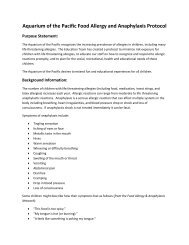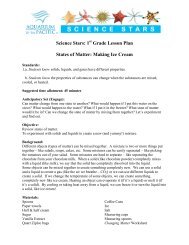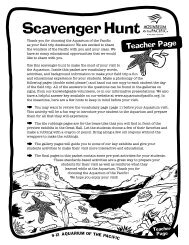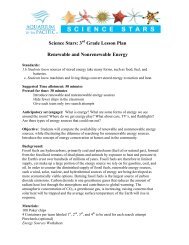4th grade Lesson Plan Ecosystem Comparison - Aquarium of the ...
4th grade Lesson Plan Ecosystem Comparison - Aquarium of the ...
4th grade Lesson Plan Ecosystem Comparison - Aquarium of the ...
You also want an ePaper? Increase the reach of your titles
YUMPU automatically turns print PDFs into web optimized ePapers that Google loves.
4 th <strong>grade</strong> <strong>Lesson</strong> <strong>Plan</strong><br />
<strong>Ecosystem</strong> <strong>Comparison</strong><br />
Standards:<br />
2.a. Students know plants are <strong>the</strong> primary source <strong>of</strong> matter and energy entering most food<br />
chains.<br />
3.a. Students know ecosystems can be characterized by <strong>the</strong>ir living and nonliving<br />
components.<br />
b. Students know that in a particular environment some kinds <strong>of</strong> plants and animals<br />
survive well, some survive less well, and some cannot survive at all.<br />
Suggested Time Allotment: 30 minutes<br />
Pressed for Time: 15 minutes<br />
Objective:<br />
Students will compare and contrast a coral reef and a kelp forest ecosystem and identify<br />
<strong>the</strong> abiotic and biotic factors within each.<br />
Materials:<br />
Blank Coral Reef <strong>Ecosystem</strong> Board (1 per group)<br />
Blank Kelp Forest <strong>Ecosystem</strong> Board (1 per group)<br />
Environmental Factors to place on <strong>Ecosystem</strong> Boards-<br />
Abiotic – warm water, cold water, trash, boats, nutrients, clear water<br />
Producers – phytoplankton, zooxan<strong>the</strong>lle, giant kelp,<br />
Primary Consumers – zooplankton, brain coral, urchin, butterflyfish<br />
Secondary Consumers – otter, kelpfish, sea turtles, parrottfish<br />
Tertiary consumers – sea lions, reef sharks,<br />
Pictures <strong>of</strong> coral reefs<br />
Pictures <strong>of</strong> kelp forests<br />
<strong>Ecosystem</strong> Observation Sheets – provided (p.14-17 in 4 th <strong>grade</strong> journal)<br />
<strong>Ecosystem</strong> worksheet – provided (p. 18 in 4 th <strong>grade</strong> journal)<br />
Set or Engage:<br />
Would you survive if I flew you to Alaska and plopped you down on <strong>the</strong> ice? What<br />
about a bear in <strong>the</strong> desert? What are some o<strong>the</strong>r habitats animals can live in besides <strong>the</strong><br />
desert? (If students say ocean, have <strong>the</strong>m be more specific) Are <strong>the</strong>se habitats different?<br />
These two habitats (show pictures <strong>of</strong> a kelp forest and coral reef) are both in <strong>the</strong> ocean<br />
but have some very specific differences. For example, a kelp forest has a giant producer
called kelp. In <strong>the</strong> coral reef, <strong>the</strong> primary producer is very small. It is a type <strong>of</strong> algae,<br />
just like <strong>the</strong> kelp, but it is microscopic and lives inside <strong>the</strong> coral. When this small algae<br />
does photosyn<strong>the</strong>sis, it produces sugars that it <strong>the</strong>n gives to <strong>the</strong> coral for food. The algae<br />
provides <strong>the</strong> coral with it well-known bright colors. (show pictures <strong>of</strong> coral reefs.)<br />
Background:<br />
An ecosystem is a system <strong>of</strong> relationships in a local environment, including <strong>the</strong><br />
relationships between organisms and between <strong>the</strong> organisms and <strong>the</strong> environment. This<br />
complex system includes predator-prey relationships, photosyn<strong>the</strong>sis, adaptations,<br />
survival, and more. Every ecosystem has primary producers. These are <strong>the</strong> plants that<br />
produce <strong>the</strong>ir own food. In most cases, o<strong>the</strong>r than parts <strong>of</strong> <strong>the</strong> deep sea, <strong>the</strong>se primary<br />
producers make <strong>the</strong>ir own food through <strong>the</strong> process <strong>of</strong> photosyn<strong>the</strong>sis. Producers are<br />
eaten by primary consumers. Secondary and tertiary consumers are animals that eat<br />
higher up on <strong>the</strong> food chain, and rely on o<strong>the</strong>r animals for food.<br />
An ecosystem not only includes individual organisms, and populations <strong>of</strong> species, but<br />
also nonliving factors that impact <strong>the</strong> living components. Depending on <strong>the</strong> ecosystem,<br />
abiotic, or nonliving factors might include <strong>the</strong> following: temperature, sunlight, surface<br />
type, wave action, water, nutrients, wind, and wea<strong>the</strong>r.<br />
Vocab:<br />
• abiotic<br />
• biotic<br />
• primary<br />
consumer<br />
• secondary<br />
consumer<br />
• tertiary<br />
consumer<br />
• producer<br />
• environmental<br />
factor<br />
• kelp forest<br />
• coral reef<br />
Modeling:<br />
1. Explain that we will look at two ocean habitats and investigate how <strong>the</strong>y are<br />
different. Introduce <strong>the</strong> term environmental factor.<br />
2. Using <strong>the</strong> “<strong>Ecosystem</strong> Observation Sheets”, brainstorm what things can impact<br />
animals that live in each habitat. Once a long list <strong>of</strong> factors is on <strong>the</strong> board,<br />
identify which are nonliving and which are living(or abiotic and biotic)<br />
3. Show <strong>the</strong> student an empty kelp forest ecosystem and coral reef ecosystem (or<br />
some simple way for <strong>the</strong> students to sort <strong>the</strong> piece.). These are <strong>the</strong> two habitats we<br />
will focus on today. While <strong>the</strong>y are both ocean habitats, <strong>the</strong>y have very different<br />
factors that allow animals to live <strong>the</strong>re.<br />
4. Starting with <strong>the</strong> abiotic factors, <strong>the</strong>n producer, primary consumers, and so on,<br />
students will place <strong>the</strong> pieces in <strong>the</strong> proper ecosystem.<br />
Guided Practice:<br />
1. Give each group a kelp forest habitat and a coral reef habitat board.
2. Pass out <strong>the</strong> abiotic options. Students will decide where each belongs.<br />
3. Pass out <strong>the</strong> bag <strong>of</strong> producers, followed by consumers.<br />
4. Provide time for students to discuss what answers are correct.<br />
Check for understanding:<br />
1. Have a kelp forest “box” and a coral reef “box” on <strong>the</strong> board. Ask <strong>the</strong> students to<br />
help you fill in <strong>the</strong> blanks for abiotic factors, producer and primary, secondary<br />
and tertiary consumers.<br />
2. Briefly discuss why phytoplankton and zooplankton can be found in all habitats.<br />
3. Ask engaging questions such as:<br />
a. Why would <strong>the</strong> otter not be able to live in <strong>the</strong> coral reef?<br />
b. What would happen to <strong>the</strong> coral if <strong>the</strong> algae inside died?<br />
c. What would happen to <strong>the</strong> kelp forest if all <strong>of</strong> <strong>the</strong> kelp disappeared?<br />
Independent Practice:<br />
Complete “<strong>Ecosystem</strong> Worksheet” to summarize <strong>the</strong> difference between kelp forests and<br />
coral reef habitats.<br />
Learning Extension:<br />
<strong>Plan</strong> a visit to <strong>the</strong> <strong>Aquarium</strong> <strong>of</strong> <strong>the</strong> Pacific. Focus your visit on <strong>the</strong> Tropical Pacific and<br />
Sou<strong>the</strong>rn California galleries.<br />
Use “The Great <strong>Plan</strong>t Race” to have students practice with manipulation <strong>the</strong> living and<br />
nonliving environmental factors that influence <strong>the</strong> success <strong>of</strong> <strong>the</strong> plant’s growth. Have<br />
students record <strong>the</strong>ir plant’s growth on <strong>the</strong> worksheet provided. Students can be creative<br />
with <strong>the</strong> following factors that can hurt or help <strong>the</strong> plant’s growth:<br />
• How <strong>of</strong>ten <strong>the</strong> plant is watered<br />
• Where <strong>the</strong> plant is kept<br />
• How much sun <strong>the</strong> plant receives<br />
• What interactions it has with living things (cats, dogs, little bro<strong>the</strong>rs)
Turtles eating jellies<br />
Parrottfish eating coral<br />
Snorkeler<br />
Eels in caves<br />
S<strong>of</strong>t coral<br />
Butterflyfish<br />
Zooplankton<br />
Octopus<br />
Anemones<br />
Clownfish<br />
Anchor<br />
Warm water<br />
Hot sun<br />
Trash<br />
Low nutrients<br />
Clear water<br />
Waves<br />
Sharks
Lots <strong>of</strong> plankton<br />
Shark egg on kelp<br />
Snorkeler<br />
Otter eating urchins<br />
Pelican diving for food<br />
Sea star eating mussels<br />
Sea lion in kelp<br />
Garibaldi<br />
Cold water<br />
Lots <strong>of</strong> nutrients<br />
Pollution<br />
Fishing line<br />
Run<strong>of</strong>f from land<br />
Rocky bottom<br />
Boat<br />
Sunlight








